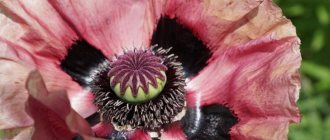When choosing plants for a flower garden, mallow is not the first thing people think of. However, novice gardeners come to the same conclusion as experienced professionals: without mallow you won’t have a beautiful and spectacular flower garden! Therefore, mallow is a perennial plant with a centuries-old history, and is still loved by many today. It looks good in the landscape of a small summer cottage, and near elite cottages. Mallow is summer and sun, brightness and beauty, calm and serenity. Let's take a closer look at this amazing flower; mallow deserves our attention.
Description of the plant
Musk mallow (Malva) is a herbaceous, perennial plant. It grows to a height of no more than 1 m. The culture received its name due to the musky smell of the flowers.
What does musk mallow look like?
The stems of the bush are densely branched. The entire surface of the mallow is covered with small hairs, including the underside of the leaf. The latter have an oval shape and are attached to the stem on elongated petioles. Along the peduncle the buds are single, and the crown is crowned with an inflorescence of three flowers.
Pearl pink or dazzling white petals in a three-lobed calyx. Because of its snow-white outfit, it is sometimes called the white bride mallow. The open bud reaches 5 cm in diameter.
The fruits of the culture are also interesting. They look like a wheel of 15-20 seeds around the middle cone.
For your information! The grass is a good honey plant and has medicinal properties. For problems with the gastrointestinal tract, a decoction of the roots of the plant has long been used. An infusion of leaves helps with non-healing wounds.
Harvesting and storing mallow
To harvest this plant, all its parts are collected: leaves, grass, flowers - everything during the flowering period. In late autumn, the roots are dug up. The flowers are picked with the calyx, the leaves are picked separately. Raw materials should be dried under a canopy in the fresh air. To do this, the grass is laid out on paper in a thin layer, turning over periodically. The leaves are stored for one year, and the flowers for up to two years.
Use in everyday life
Even in ancient times, people grew this flower as a spinach-salad crop, which was used in cooking. It is used to make food dye, as well as a dye that perfectly dyes wool gray and purple. Mallow is used to prepare cosmetics at home. Infusions from it are used for washing. Anti-aging masks are prepared from the leaves and flowers of the plant. Rinse hair with a decoction to improve hair growth.
Growing mallow from seeds
Perennial mallow - planting and care
When growing a plant from seeds, there is always a danger of getting a specimen that is not similar to the parent bush. Often the characteristics of wild ancestors take over. But many gardeners like this method of getting new bushes.
Sowing
Seeds are sown in 3-4 pieces. in one hole. The depth of the planting hole should not be more than 1 cm. The distance between the holes is maintained at 30-45 cm.
Musk Mallow Seeds
The best time for sowing mallow is May. The seeds hatch in 18-24 days.
When sowing in autumn, the depth of the holes is 3-4 cm. It is necessary to protect the crops from frost.
Seedling care
Mallow seedlings begin to germinate at the end of winter. Step-by-step description of the procedure:
- Prepare containers with the nutrient mixture.
- Place seeds in shallow holes and sprinkle with soil.
- Moisten the soil.
- Cover with film.
- Provide a temperature range from 18 °C to 20 °C.
- Monitor soil moisture.
On the 8-10th day of planting, hardening should begin. After three true leaves appear, they can (but are not advisable) be picked.
Important! Before planting in open ground, seedlings must be hardened off. To do this, they can be taken out onto a loggia, terrace or balcony.
Euphorbia fringed
Another name - Euphorbia marginata - is a real decoration of the garden. Euphorbia looks very solemn and elegant due to its soft green leaves with a white border. Due to these qualities, and also because the bush grows very quickly, it is popularly called the “rich bride.”
Characteristics and conditions of detention
The bride is a perennial flower, but in fact in most regions of Russia this plant is cultivated as an annual. In winter, the entire above-ground part freezes. But already in the spring a whole scattering of young seedlings appears from seeds spilled by milkweed on the ground.
Perennial garden flower Bride
The height of the bush under favorable conditions reaches 90 cm. At the very top of the shoots there are small flowers. But they are not the main decoration of this planting, but the leaves with a white border, due to which it seems that the bush is all in bloom.
The landing site should be well lit by the sun. The brightness and power of the bush depends on this. Euphorbia prefers soil that is light, loose, air- and water-permeable.
Care
Watering milkweed is done regularly, but in moderation. Excess moisture can lead to rotting of the roots and death of the bush. After each watering, the soil is loosened. Euphorbia grows well, so it can bend under the weight of its mass. To avoid this, the plant is tied up.
Flowerbed with the bride
In the spring, when the seedlings have already grown, the soil is fed with organic matter. Then, several times a season - with complex fertilizers. The bride, as a rule, is not affected by diseases and pests.
Reproduction
There are 2 ways to grow garden flowers on your property: cuttings and seeds. It is possible to grow by cuttings, but it is not advisable, since a lot of seeds are collected from the plant and they germinate well.
Seeds should be sown in the fall, after the possibility of germination has disappeared. The best time is before snowfall. When the snow melts, it will pull the seeds into the ground, where they will germinate in the spring.
Planting in autumn
In addition to growing in the garden plot, the perennial flower bride is planted in beautiful flower pots to be kept on terraces, porches, well-lit balconies and loggias. It can also be used to make wedding bouquets.
Attention! Euphorbia juice is poisonous, so you need to wear gloves when working with it: sensitive people may experience allergies.
Planting mallow in open ground
Mallow is planted in open ground in the form of rooted cuttings.
How mallow propagates - planting methods
The soil for planting should be rich in organic matter and loose. To avoid stagnation of water, a well-drained area is allocated for planting.
Up to half a meter of distance is left between future bushes. Seedlings are planted one at a time.
When to plant
Rooted cuttings can be planted in open ground until mid-summer. Before winter, the young plant will have time to adapt and take root well.
Seeds can be sown in early spring and before winter. Autumn sowing requires shelter for the winter. Dry leaves, spruce branches, straw, etc. will do.
How and where to plant
It is very important to plant a plant with a strong root system. It is best with an untouched clod of earth. In this regard, it is difficult to replant mature plants. Its tap root is quite long.
Important! Even when sowing, it is better to sow seeds in individual containers. When picking, many seedlings die.
For abundant flowering and optimal decorativeness, it is advisable to plant mallow in a place protected from the winds.
The healing properties of mallow
This plant has long been used in folk medicine. It has many healing properties well known to healers from different parts of the world. For example, an infusion prepared from leaves and flowers has long been used to treat inflammatory processes in the stomach, as well as intestinal disorders. If you steam the foliage or flowers of wild mallow (mallow) and add it to a hot bath, then taking it will help you get rid of a spleen tumor as soon as possible. Mallow herb is included in almost all breast preparations. A decoction is made from the flowers, which is used for compresses and lotions for various skin diseases. They perfectly eliminate itching and also promote the speedy healing of wounds (most likely due to the mucus found in such a plant). Such flowers are also used in medical cosmetology, as they are able to restore the epidermis, as well as have a preventive effect against pustular rashes. Flowers are most often used in folk recipes, as they contain more vitamin C, sugars and keratin than foliage. And all such folk remedies have no contraindications or side effects. This plant has a softening, enveloping, restorative, expectorant, reparative, and anti-inflammatory effect.
Cough-relieving tea: pour 2 full small spoons of crushed fresh flowers or leaves into a glass and fill it with freshly boiled water. Let sit for 10 minutes and then strain. You should drink 2 or 3 glasses per day. If you want to add honey to the drink, then in this case you need to wait until the infusion is not hotter than 40 degrees.
In the month of May, the Aoi Matsuri festival, which is held in honor of the mallow, is held annually at Kamigam, which is a Kyoto temple, and directly in the city itself. At the same time, people dress in richly colored clothes and parade through the city streets singing and dancing. This holiday originated several hundred years ago...
Caring for mallow in the garden
Perennial carnation - planting in the garden and care
Perennial nutmeg mallow purifies the air in the environment. At the same time, it requires a person to enrich the soil.
Therefore, the flower needs to be looked after, that is, fertilized, watered and weeded. Ideally, it is enough to feed the bushes once every three weeks. The main thing is that the complex contains:
- potassium;
- nitrogen;
- phosphorus.
In spring, it won’t hurt to scatter humus over the flowerbed.
Systematic removal of wilted buds and leaves will increase the decorative value of the bush and will prevent diseases and pests.
Before frost, the mallow is cut off at the root. To avoid freezing of the roots, the area with the hollyhocks can be thickly mulched (straw, sawdust, leaves, compost).
How to water a plant
The frequency of watering depends on weather conditions. In hot weather, it is recommended to water 2-3 times a week. In normal weather, weekly irrigation is sufficient.
The water should be settled and warm. Watering is done at the root of the plant.
For good aeration of the root system, watering should be combined with loosening and weeding (at least every other time).
Features of mallow
Wood mallow is the most common representative of this genus. The height of the shoots can vary from 30 to 120 centimeters. They can be either lying, straight, or ascending. The surface of young stems is covered with hairs, which disappear over time and the shoots become bare. Petiolate, 5–7 lobed or incised leaf plates have a round or heart-shaped shape. They have a petiole and pubescence on the surface. The diameter of the flowers can reach 12 centimeters. Their shape is similar to a wide bell. On the surface of the flower there are purple stripes characteristic of mallow. They are located in the leaf axils of 1–5 flowers. There are species with racemose inflorescences. The flowers can be simple or double, and their color directly depends on the variety and can vary from white to almost black. The deeply concave oblong petals have an obovate shape. The long branched rhizome has a spindle-shaped shape. The fruit is a polysperme, the seeds remain viable for 2–3 years. Flowering is observed from the beginning to the end of the summer period. Mallow is resistant to frost, drought, and is also very easy to care for.
MALVA OR ROSE STOCK FROM SOWING TO COLLECTING SEEDS / ALL THE SECRETS OF GROWING MALVA
Reproduction
Mallow propagates well from cuttings. To germinate, the branches should be planted in the ground.
Mallow cuttings
Planting material is cut from the middle of a healthy stem. Late spring and summer are suitable for this.
Important! The sections should be sprinkled with crushed coal or cinnamon powder. This will disinfect the wounds and stop the secretion of juice.
For seedlings, you can use ready-made soil or prepare it yourself. A mixture of turf soil and peat (humus) is best suited.
With regular watering, the cuttings will soon take root. This can be understood from the external manifestations of the seedling: it does not wither, but begins to grow.
The bride mallow is planted in a permanent place with a lump of earth.
Annual mallow with photo
More than 50 varieties are available for cultivation . This quantity was achieved thanks to the efforts of breeders.
The ancestor of modern varieties is wood mallow, an annual plant, while the hybrid and wrinkled varieties bred on its basis are cultivated as perennials.
Forest (Malva sylvestris)
The height of the plant does not exceed 120 cm. Its distinctive feature is its large, rich pink, bell-like corollas with thin longitudinal stripes of deep purple color along the petals.
Popular varieties of wood mallow are lilac zebrina and black mother of pearl.
Purple annual
A variety with purple-pink petals. Plant height is about 100 cm.
Diseases and pests
Mallow is protected from infection by fungal diseases by the phytoncides it produces. But with improper care or unfavorable weather conditions, the protection weakens.
A weakened plant is attacked by all kinds of fungal diseases:
- spotting;
- powdery mildew;
- leaf rust;
- stem cancer;
- mosaic virus.
With a low degree of damage, diseased parts can be torn off and disposed of. Severe lesions are treated with the following drugs:
- trichodermin;
- phyto-doctor;
- mikosan-V.
Aphids and spider mites are also dangerous for mallow. Insecticides will help against them:
- fitoverm;
- kinmix;
- fufanon.
Important! If pests appear on mallow, neighboring plants should also be inspected.
Flowering and care during this period
Muscat mallow begins to bloom in early June and continues until frost. During this period, the plant needs feeding and regular watering. The necessary elements during this period are potassium, nitrogen and phosphorus. In order not to spoil the decorative appearance of the bush, wilted buds must be removed. Experts also advise inspecting plantings for pests and infectious diseases.
Pink mallow
How and when to collect seeds
New plants usually appear by self-sowing, which can disrupt the layout of the flower garden. Therefore, without waiting for this, you should collect ripened seeds in advance. The readiness of the seed pods can be seen by their color changing to yellow. Next, you need to cut off the seed pods and remove the seeds from them.
Note! To store them, they need to be dried at a temperature of 10 ° C for about two weeks. In a paper bag at room temperature, the seeds remain viable for 2-3 years.
Preparing for winter
A plant in the garden can overwinter without shelter. Before the first frost, spent stems are cut out. Until spring, the cut shoots can be left in the flowerbed. They will serve as some guarantee during severe frosts and will help to retain snow over the plantings (additional cover). Moreover, in the spring, excess moisture will not hurt.
Unnoticed
Unnoticed mallow grows like a weed along roadsides and in the courtyards of private houses. Known as kalachiki, neglected mallow. In childhood, many people feasted on the young greenery of the plant. Grows up to 1 meter in height.
The stem can be recumbent or ascending with 5-7 lobed pubescent leaves on long petioles, shaped like a heart. The flowers are not as elegant as those of their double relatives, but attract the eye with the delicacy of pink or purple petals. Each flower has 5 petals that taper towards the base.
Mallow Unnoticed
Mallow in landscape design
The plant is often used in landscape design, especially in a rustic style. Mallow looks great as a central figure in a flower garden, or for zoning individual areas. A flowerbed consisting of different varieties of mallow looks very harmonious. The musky bush is combined with delphiniums, dahlias, and marigolds. With them, mallow will form a composition that blooms until frost.
Flowerbed of hollyhocks
Experienced gardeners decorate fences, walls of houses and other buildings with them.
If you follow some simple rules, musk mallow will grow beautifully in any area. It will delight you with lush flowering and a delicate musky scent until frost.
Popular types and varieties
The most basic and popular include: Sudanese rose, hollyhock, alcea rugosa and lilac zebrina. Each has its own characteristic highlight, which makes it unique and is clearly visible in the photo.
Sudanese mallow
Hibiscus or Sudanese rose is a giant among its genus - it is an ornamental biennial that grows up to 3 meters in height and blooms with large red buds up to 10 cm in diameter, which cover the peduncles like a spike. There are both shrub and tree varieties.
Basically, the Sudanese rose is grown solely for its beauty, but in addition it also has medicinal properties, and delicious drinks are made from its fruits:
Due to the high content of bitterness, starch, tannins (as in cabbage), minerals and plant mucus, it has expectorant properties and, in combination with other medications, even cures bronchitis.
Tinctures and decoctions have anti-inflammatory properties and are used in the treatment of intestinal disorders and gastric diseases.
Tinctures from the inflorescences are used for indigestion, as well as for rinsing the mouth and throat during inflammation.
Sudanese tincture is an effective diuretic and is sometimes used to dry the body from excess water.
Sabdariffa
Sabdariffa is one of the most popular hibiscus shrubs. It is bred solely for the purpose of collecting fruits, which are used in the preparation of various fruit drinks.
Altissima
Tree variety of sabdariffa. Most popularly known as hibiscus tea, which is made from the petals of the plant's inflorescences. Various jellies, compotes, sauces are also prepared from them, pickled, salted and used as food coloring.
Grown mainly in Sudan, Egypt, Java, Ceylon, Mexico, China and Thailand.
Stock rose
A species of woolly-hairy annual, biennial and occasionally perennial. Mature bushes reach a height of 30 cm to two and a half meters. Flowers are yellow, red, pink, purple and white. The greenery is plentiful and large. Flowering period from July to August.
Majorette Mixed
One of the most popular varieties of wrinkled mallow, majorette mixed is considered a dwarf plant compared to other representatives of the genus, and this is with a height of about 60-75 cm. The flowers are large, semi-double, of various shades. It tolerates frost well, which is rare for this heat-loving family. The variety itself was obtained by crossing pale marshmallow and pink mallow.
Single Mixed
One of the varieties of Alcea rugosa. It is distinguished by its varied flowering and shiny texture of buds. The flowers are similar in shape to sabdariffa inflorescences. Mature bushes reach 150cm.
Powder Puffs Mixed
The second largest variety of Alcea rugosa after Zebrina lilac. Powder mixed grows up to one to one and a half meters. Double flowers of various colors. They look very aesthetically pleasing in any garden ensemble. And even the most picky critic will appreciate their pleasant aroma.
Zebrina lilac
It is not difficult to guess that this is a flower with lilac buds. Zebrina lilac is also a perennial plant, which makes it indispensable in landscape design. But its advantages don’t end there:
- Unpretentiousness.
- Zebrina tolerates drought and Russian winter.
- Feels equally good completely alone and surrounded by other plants.
- Zebrina can be planted both in open ground and in a decorative pot or mixboard.
- Retains freshness and aroma for a long time when cut.
From preferences: she loves light, fertile soil and a lot of sunlight.
Summer Carnival
Summer Carnival is a mixture that eliminates the need to look for good combinations. It is enough to choose a site for planting - a flower bed, or a fence, or even a wall, or any vertical surface is suitable for this. Choosing vertical surfaces is preferable to a flower bed, since the plant is large and needs protection from the wind.
This variety grows in height from 150 to 180 cm. The flowering period begins at the beginning of August and ends in September. It blooms even when cut, if the bud has not yet opened - just put the flower in a carafe of water, and it will fill the entire room with its aroma for quite a long time.
Mallow wrinkled
Otherwise, Alcea rugosa is a two-meter perennial giant with small yellow flowers only about 3 cm in diameter. Although there are representatives with much larger inflorescences. In general, gardeners prefer to grow varieties such as Single Mixed, Powder Puffs Mixed or Majorette Mixed.
Musk mallow
A species literally created to become a huge beautiful bouquet of snow-white flowers. The bouquet is musky and growing - the bush literally falls apart when all the flowers bloom on the numerous stems. Therefore it needs to be tied up. In common parlance, she is called the bride, which once again emphasizes the effectiveness of her delicate snow-white flowers.
The main thing for planting is to choose a well-lit area with light soil, and then the bride will do everything herself, since she reproduces well by self-sowing.
Perfection
White Perfection is a dwarf variety of the musk rose plant. Perfection has the form of a bush up to 60cm high. During the flowering period, it is densely dotted with white inflorescences.
Pink Tower
Another musky variety, the largest of all - up to 100cm. The main varietal difference from the classic one is the delicate pink tones of the buds. The pink tower is easy to care for and will be an excellent addition to the plant ensemble of your flower garden. The main thing is to choose a well-lit place for this. Wind protection is not required, but is advisable.
White Tower
The variety is in many ways similar to the pink tower, only slightly lower - up to 70cm. And, of course, not with pink petals, but with white ones. Well suited for bouquets - it retains freshness and aroma for a long time when cut.
Annual
A direct descendant of the forest mallow or simply “kalachiki”. In its natural habitat it is a biennial, but in the garden it is used as an annual. Although, in order for it to decorate your hacienda, it is necessary to plant it every year - this is more than compensated for by its long flowering duration and unique aroma.
An adult bush is about 1.2 meters with flowers about 7cm in diameter.
The most popular representatives: black mother of pearl and pink zebrina.
Perennial
Mallow is perennial. From a botany point of view, there are not many perennial plants in the family, but there are enough for gardeners. Perennials include:
- Tree hibiscus. Decorates the garden throughout the summer season.
- The rose stock is wrinkled.
- Sudanese rose. Otherwise, bambia or hibiscus.
- Hybrid.
- Musky or nutmeg.
In order not to make a mistake when choosing, it is worth considering that breeders have bred many different flowers and often make annuals from perennials and vice versa.
Hybrid
A very bushy and prolific perennial up to 2 meters high. It blooms for a fairly long period - from June to September inclusive. The buds are large, open up to 10cm and delight the eye with white and pink tones. The most popular hybrid varieties among gardeners are Chater's Double, Powder Puffs and Gibbortello.
Chater's Double
A group of hybrids up to 2 meters with flowers of various shades, including the following names: Chater's Double Pink, Chater's Double Violet, Chater's Double Icicle and Chater's Double Salmon.
Powder Puffs
An impressive hybrid plant up to 2 meters tall. One bush can produce one or two stems with large white and pink flowers, similar in appearance to a rose, only with smaller and more frequent petals and a more rounded shape. Due to its lush flowering and volume, it is often used in landscape design to decorate buildings, gazebos, gates or fences.
Gibbortello
Another hybrid. A distinctive feature of the plant is its large and delicate purple flowers with dark purple, almost black veins, spreading in a network from the base of the petals to their edges.











